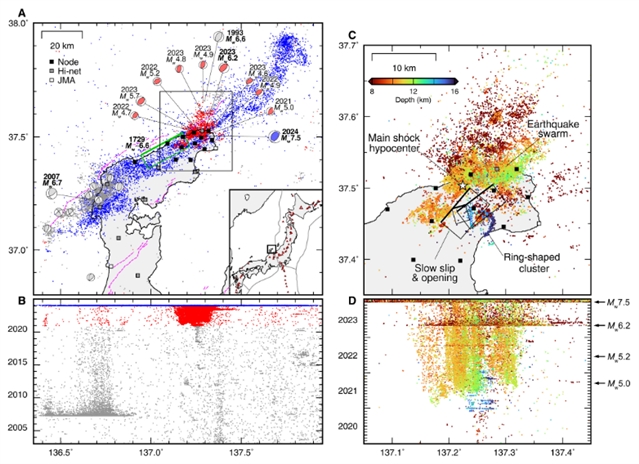
近日,日本东北大学Ryota Takagi团队揭示了凝固的古代岩浆破裂阻碍了之前的群体迁移,导致2024年能登地震。2025年10月17日出版的《科学进展》杂志发表了这项成果。
持续约3年的强烈地震群最终导致了2024年在日本能登半岛发生的7.5级地震。人们已观察到群体演化和地震破裂的空间复杂性,但控制这些复杂性的因素尚不清楚。
通过高分辨率的地下成像和密集的地震观测,研究组发现了一个高速体,它与主要滑动带重合,而之前的地震群避开了它。高速体的空间分布和绝对速度以及邻近的环形群热仪表明高速体为凝固的古岩浆。它最初作为一个不可渗透的屏障,阻止了引发群震的流体迁移,最终在2024年的地震中破裂。该观察表明,断层带渗透率的非均质性,源自于古代火山活动(1500万年前),控制了当今的群演化和大地震的发生。
附:英文原文
Title: Rupture of solidified ancient magma that impeded preceding swarm migrations led to the 2024 Noto earthquake
Author: Ryota Takagi, Keisuke Yoshida, Tomomi Okada
Issue&Volume: 2025-10-17
Abstract: An intense earthquake swarm lasting ~3 years ultimately led to the 2024 Mw (moment magnitude) 7.5 earthquake in the Noto Peninsula, Japan. The spatial complexities in swarm evolution and earthquake rupture have been observed, but the factors controlling these complexities remain unclear. Using high-resolution subsurface imaging with dense seismic observation, we identified a high-velocity body collocated with the major slip zone, which the preceding swarm avoided. The spatial distribution and absolute velocity of the high-velocity body and the adjacent ring-shaped swarm cluster indicate that the high-velocity body is a solidified ancient magma. It initially acted as an impermeable barrier to the fluid migrations that triggered swarm earthquakes, eventually rupturing as an asperity of the 2024 earthquake. Our observation suggests that the heterogeneity in fault zone permeability, originating from ancient volcanic activity (>15 million years ago), controlled the present-day swarm evolution and the large earthquake generation.
DOI: adv5938
Source: https://www.science.org/doi/10.1126/sciadv.adv5938
